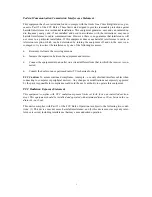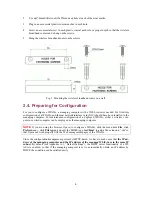
Repeater.
A wireless router can communicate with other wireless APs/routers via WDS
(Wireless Distribution System). Therefore, a wireless router can wirelessly forward packets
from wireless clients to another wireless AP/router, and then the later AP/router forwards
the packets to the Ethernet network.
Wireless client isolation.
Wireless-to-wireless traffic can be blocked so that the wire-
less clients cannot see each other. This capability can be used in hotspots applications to
prevent wireless hackers from attacking other wireless users’ computers.
AP load balancing.
Several wireless APs/routers can form a load-balancing group.
Within a group, wireless client associations and traffic load can be shared among the wire-
less APs/routers.
Transmit power control.
Transmit power of the wireless router’s RF module can be
adjusted to change RF coverage of the wireless router.
Replaceable antennas.
The factory-mounted antennas can be replaced with high-gain
antennas for different purposes.
Showing associated wireless clients.
Showing the status of all wireless clients that
are associated with the wireless router.
Internet Connection Sharing
DNS proxy.
The wireless router can forward DNS (Domain Name System) requests from
client computers to DNS servers on the Internet. And DNS responses from the DNS serv-
ers can be forwarded back to the client computers.
Static DNS mappings.
The administrator can specify static FQDN (Fully Quali-
fied Domain Name) to IP address mappings. Therefore, a host on the internal network
can access a server also on the intranet by a registered FQDN.
DHCP server.
The wireless router can automatically assign IP addresses to client com-
puters by DHCP (Dynamic Host Configuration Protocol).
Static DHCP mappings.
The administrator can specify static IP address to MAC
address mappings so that the specified IP addresses are always assigned to the hosts
with the specified MAC addresses.
Showing current DHCP mappings.
Showing which IP address is assigned to
which host identified by an MAC address.
NAT server.
Client computers can share a public IP address provided by an ISP (Internet
Service Provider) by NAT (Network Address Translation). And our NAT server function-
ality supports the following:
Virtual server.
Exposing servers on the intranet to the Internet.
PPTP, IPSec, and L2TP passthrough.
Passing VPN (Virtual Private Network)
packets through the intranet-Internet boundary. PPTP means Point-to-Point Tunneling
Protocol, IPSec means IP Security, and L2TP means Layer 2 Tunneling Protocol.
DMZ (DeMilitarized Zone).
All unrecognized IP packets from the Internet can be
forwarded to a specific computer on the intranet.
2








































